25 November 1778 Wednesday
. . . . . .
25 November 1785
Carl Fredrik Fredenheim (1748-1803), a Swedish nobleman close to the King and master of ceremonies at court, wrote to Francesco Piranesi asking him for a list of all the works of art belonging to Baron Taube that had been recently dispatched in cases from Rome to Sweden, since the Baron had recently died.
25 November 1795
Death of Jonas Åkerström; Francesco Piranesi and Carlo Bassi were present at his deathbed.
25 November 1812 Wednesday

Morning without a cloud, moisture on my chamber windows frozen, temperature said to be 23 degrees in town. About 10 I went to 4th Street store without s......, remained there 3 hours, got chilled, paid sundry debts of my son, dined in Mulberry Street. 1/2 past 3 ....... .. W. Lewis, ... appointment, none coming at .... his leave to attend the funeral of my old acquaintance Geo. Emlen, to which I had received a particular written invitation in the forenoon. Spent the evening M. Street. Small rain.
25 November 1999 Thursday Thankgiving
It is within this southern half of Speer's plan that we see the proposed Triumphal arch, which spans the center line of the axis--the arch is actually more of a double arch as the plan indicates. The Grossbelastungskorper was a 'foundation' test for this enormous arch--as the scale comparisons demonstrate, e.g., the arch would have been bigger than two square blocks of historic Turin--and thus I'd say that the Grossbelastungskorper is presently ever so slowly sinking somewhere in the (West) Berlin neighborhood called Kreuzberg.
I'm now reminded of what Kai Voeckler told me when we first met (before our respective presentations), and I immediately asked him what is this "Grossbelastungskorper"? He told me what I've relayed here at design-l, but he also added this uncanny anecdote: apparently there is historical evidence, in the form of a letter or memo, that Speer and his fellow planners /architects where actually happy about some the early Allied bombing of Berlin because some of the bombing hit neighborhoods along the planned North-South Axis. Because of the bombing then, the bureaucratic task of condemning and demolishing the properties and existing buildings in way of the proposed 'super-axis' was suddenly an un-moot point. I suppose this is yet another example where the Nazis fatally demonstrated the very thin line between extreme efficiency and horrific inanity.
While Kai and I were together as part of the "Thinking Density" group panel, I pointed out that Speer's Berlin, like Piranesi's Campo Marzio, has ancient Roman reenactment written all over it.
the two Elenis
Two of the architects I met almost immediately in Brussels at the INSIDE DENSITY colloquium were both named Eleni--Eleni Gigantes and Eleni Kostika. We were members of the same "Thinking Density" session, and they presented their paper--Greece: Seasonal Densities, Built Density, Landscape Saturation--the ongoing transformation of a country through tourism--after I presented my paper. Upon hearing their talk, it wasn't difficult to see that our two papers had some strong similarities in that what happened in Greece vis-à-vis 'constructed' tourism comes very close to what Piranesi did within the Campo Marzio vis-à-vis reenactment. I quickly mentioned this similarity to the two Elenis in-between two of the subsequent papers, and then, during the session break, the three of us had a lengthy discussion regarding "what is reenactment?". I used Princess Diana's funeral as an easy example of ancient Rome's triumphal way being reenacted, and also said that modern Greece may in some circumstances be trying to reenact its ancient glory as an ingredient for tourism. Eleni Kostika still questioned the notion of reenactment, however, and offered that perhaps anything (or everything?) is indeed a reenactment of something. In the midst of all this, we found ourselves talking about Thanksgiving Day in the USA (actually it was Thanksgiving Day, but we were in Brussels), and it quickly dawned on Eleni Gigantes that Thanksgiving Day is a huge reenactment (if not the biggest reenactment within the United States).
I then turned the conversation into something the two Elenis did not expect, namely my work this year involving St. Helena, and my thesis that she was the first master architect of Christianity. Eleni is the original rendition of the name Helena, and I told Eleni and Eleni that they had no idea how thrilled I was to be sitting in Brussels having just met two architects named Eleni, and to be discussing architecture and reenactment with them. Of course, I gave them a quick synopsis of my thesis, and Eleni Gigantes absorbed it all most agreeably, while Eleni Kostika seemed to remain somewhat circumspect.
Just before going to Brussels, I had come to the conclusion that for me to effectively write about St. Helena's role as first master architect of Christianity, I had to concede that I, like many before me, would be writing yet another legend of St. Helena. Today, legends are usually thought of as popular myths (with myth being the operative word), but, by its first definition, a legend is indeed the story of the life of a saint. In either case, meeting Eleni and Eleni, two woman architects, in Brussels is a big part of my legend of St. Helena.
That night, as I lay sleepless in my hotel room, I thought about the strange coincidence of meeting two Elenis, and first I thought of the 'odd' and rare double early Christian basilicas that were built towards the end of Helena's life (the last of which still stands as (the many times rebuilt) double churches in Trier, Germany). And then I wondered whether Eleni Gigantes and Eleni Kostika, since both are architects, offer any insight into St. Helena's personality. And then I wondered whether a combination of Eleni Gigantes and Eleni Kostika provides a real glimpse of St. Helena [as architect].
Read this morning from “A Conversation with Elia Zenghelis” in Log 30:
CD: Charles Jencks called the Sphinx surrationalist architecture. Not surreal, but surrational. For Jencks, surrationalist was a neologism for the reunion of real urban function and existing urban fantasy. Was the Sphinx a union of function and fantasy, and did that make it surrationalist, as opposed to pure rationalism?
EZ: Charlie [Jencks] is a whiz-kid of isms and it is best left to him to decide on them. We were neither advocating nor opposed to any isms, but we did not adhere to any either—and Charlie’s would not be an exception. Equally, we were not necessarily opposed to pure rationalism; we just did not adhere to it. And we were certainly not against modernism, which we saw as an unfinished chapter.
Here we enter a whole discussion about “trends” and “factions.” I always feel uncomfortable with classifications. I disagreed with trends that searched for “newness,” as I believed there was nothing new to be discovered. For example, Archigram rejected rationalism as it had evolved, and they were moving away from what they saw as indoctrination, which they considered boring. In adopting a pop imagery, they were celebration consumerism.
But to go back to your question about the surrational: we did find surrealism inspiring for our purposes, as it inverts architectural drawing with a substitute reality, with hidden promises that are enigmatically calm and motivating. In the case of Dalí, what is often seen as cheap sensationalism is explained in The Secret Life of Salvador Dalí as the product of memory and moments of boredom. When children get bored they resort to imagination, they invent. Dalí recalls the walks that his nanny would take him on along the coast of Cadaques, where he grew up. The nanny would sit on the beach, ignoring him. In his intense boredom, Dalí would see a window carved out of her fat body, and inside that window, a fantastic and hallucinatory landscape would emerge that would mesmerize him. And there is an exact painting of this description. He also describes his memories as a growing embryo in his mother’s womb. It’s all beautifully described in a chapter about “intra-uterine memories.”
So I suppose what Charlie calls surrationalism could be an application of the same method to the processes of rationalism: a method by which a window of fantasy opens onto the landscape of reality.
What strikes me most from within the above passage is Zenghelis saying “as I believed there was nothing new to be discovered.” I met Zenghelis at the 'Inside Density’ symposium, Brussels, November 1999—I presented a paper on Piranesi’s Campo Marzio and Eleni Gigantis, Elia’s wife, presented a paper after mine. We all met after presenting our respective papers, and the first thing Zenghelis said to me was, “You showed something new!”
He was referring to this . . .
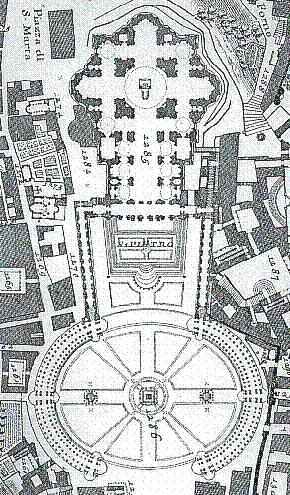 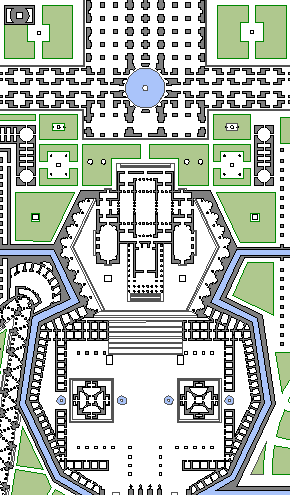
as dense as architecture can get?
The last paper of the "Thinking Density" session at Inside Density was presented by Kai Vöckler (a kind of new universal man from Berlin -- architect, painter, writer, publisher) and entitled "Monument of density: Albert Speer's 'Grosbelastungskörper'". This Grossbelastungskörper was the punctuation point for both of Inside Density's days--Kai's presentation was the last on Thursday, and Mark Wigley incorporated the Grossbelastungskörper into the conclusion of his keynote address which ended the colloquium on Friday.
The Grossbelastungkörper is this enormous solid concrete cylinder about 4 stories high with a diameter about four times its height. It sits in Berlin along the middle of what was to be the great north-south axis of Speer's Third Reich plan for Berlin. The Grossbelastungkörper was actually a 'structural' test to see if the ground in that part of Berlin could withstand the weight of the enormous triumphal arch proposed for the midpoint of the grand axis. This thing, which is best described in terms of its present context as something that is just there without being able to be gotten rid of, weighs 152,000 tons, and, albeit only slightly, measurably sinks as each year goes by. When all the presenters of "Thinking Density" were together on stage, I referred to the Grossbelastungskörper as this great inverted monument, in that, as big and impossible to remove as it is, it's now just a big nothing representing an even bigger [architectural] non-event.
That night I found my self wondering, given it current rate of sinkage, how many years it would take this thing to reach the Earth's core. Of course, I quickly realized that the geological/physical changes this thing would go through as it sunk deeper over time meant it would never actually reach the core in one piece, if at all. So I limited my speculating to wondering how many years it would take for the top of the Grossbelastungskörper to become even with Berlin's ground plane.
Perhaps the Grossbelastungskörper is precisely the design that proves something in that it is a big something that proves the eventual existence of the big nothing.
25 November 2002
Re: Barnett Newman
There is also the notion [within the theory of chronosomatics] that the operations of the mind, i.e. imagination, reenact the (physiological) operations of the body. For example, there is a fertile imagination, an assimilating imagination, a metabolic (creative/destructive) imagination, an electro-magnetic imagination, etc. According to the chronosomatic gauge, humanity in our time operates mostly via a combination of an assimilating and metabolic imagination.
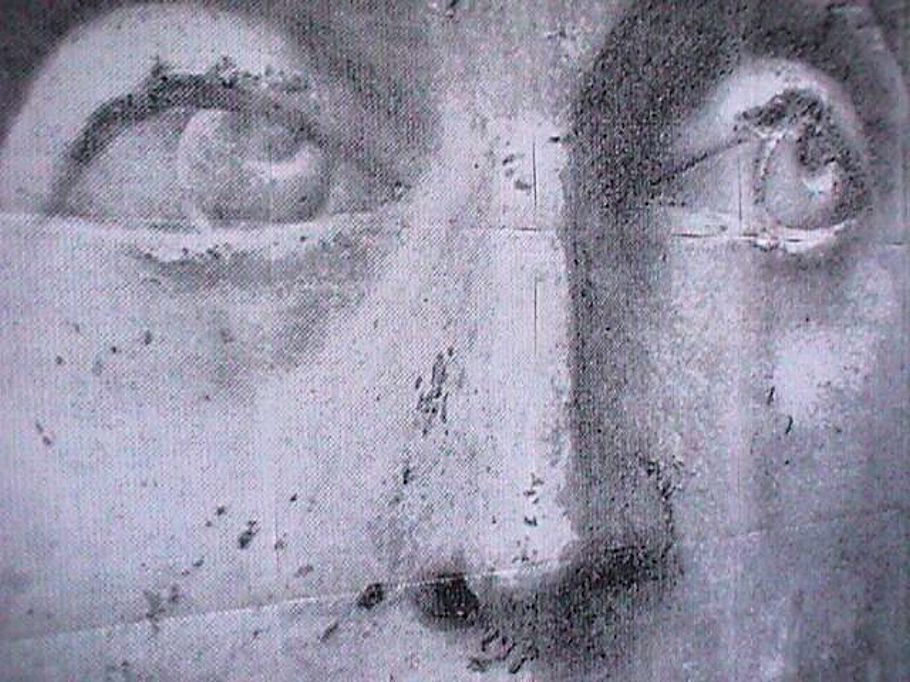
25 November 2004
Re: Deconstruction? no, afterlife
papers of LEAVING OBSCURITY BEHIND
Reenactionary Bilocating Architecturism
Saint Catherine de Ricci and Louis I. Kahn
Nudist Camp at the Philadelphia Museum of Art
Marcel Duchamp and C. Paul Jennewein
Learning From Lacunae
Gordon Matta-Clark
De Spectaculis II
Quintus Septimus Florens Tertullianus and John the Baptist Piranesi
The Promenade Architecturale Formula
Le Corbusier
The Marriage of Twisted and Columns
Eutropia and Pieter Pauwel Rubens
Pilgrimage, Reenactment and Tourism
Flavia Julia Helena Augusta
Here a Versailles, There a Versailles, Everywhere a Versailles Sigh
Marie Antoinette, Ludwig II, and Lucretia "Eva" Bishop Roberts Cromwell Stotesbury Dougherty
and maybe
De Spectaculis III
Guy Debord
25 November 2018
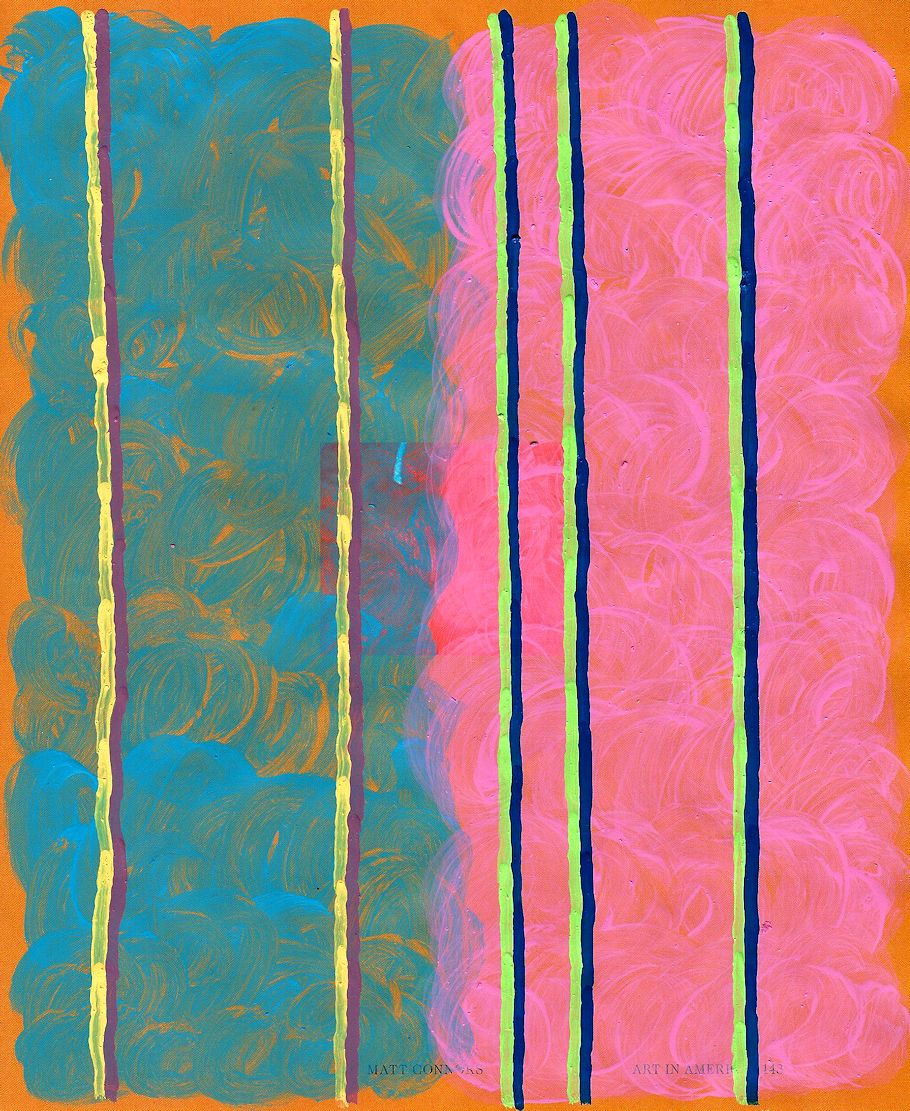
page painting 051
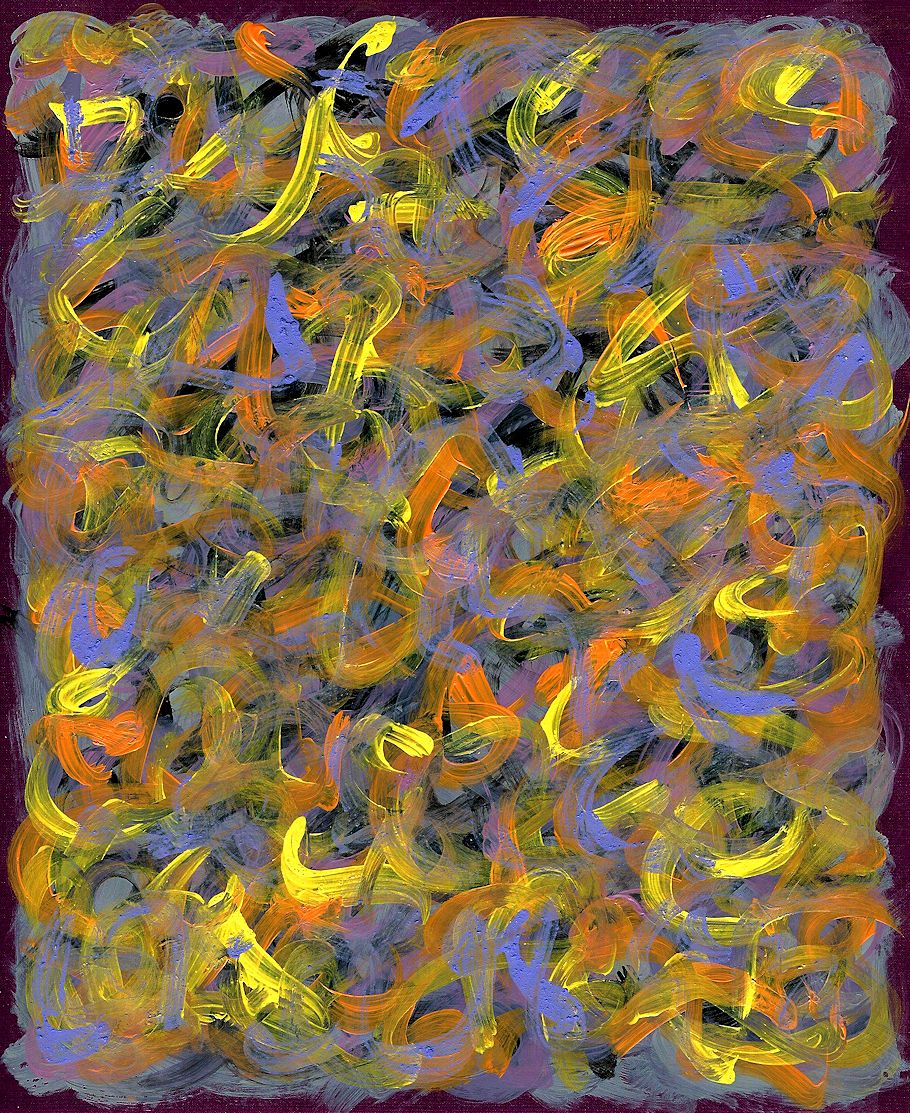
page painting 052
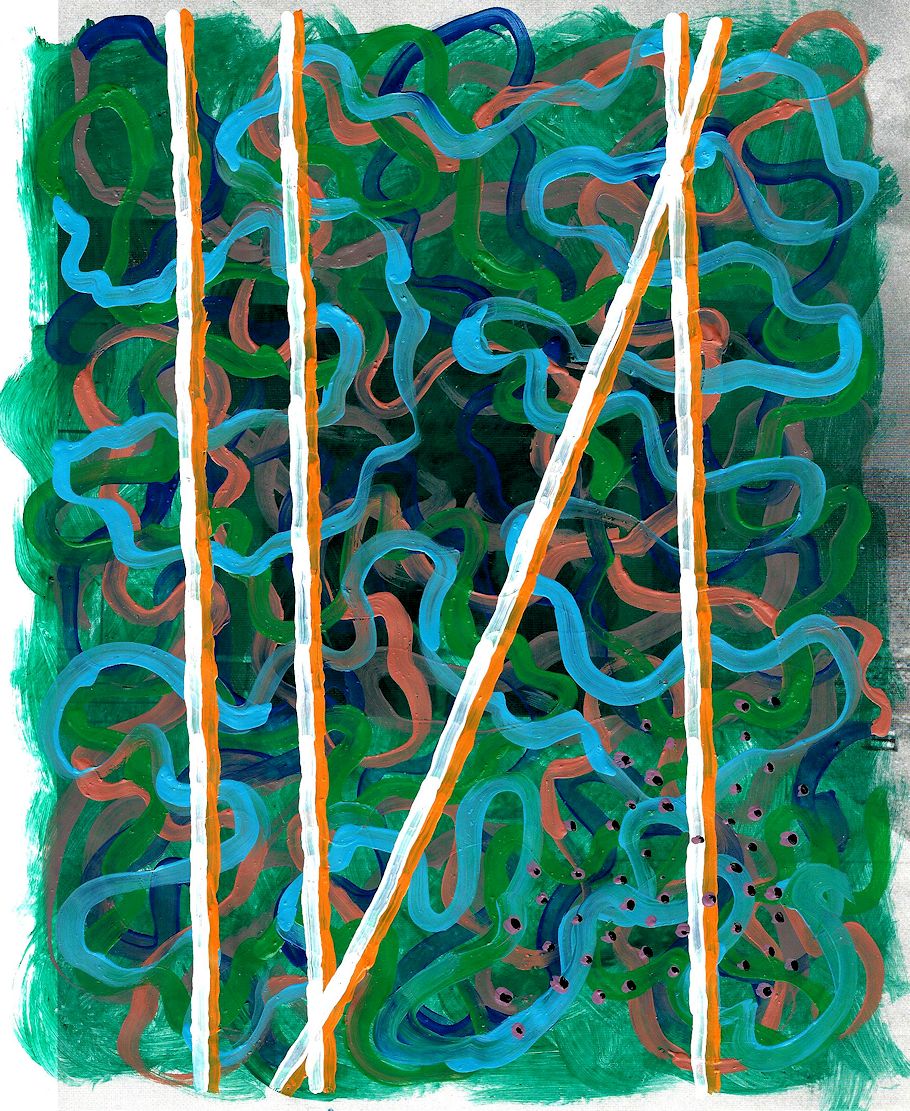
page painting 053
25 November 2022 Friday
. . . . . .
|